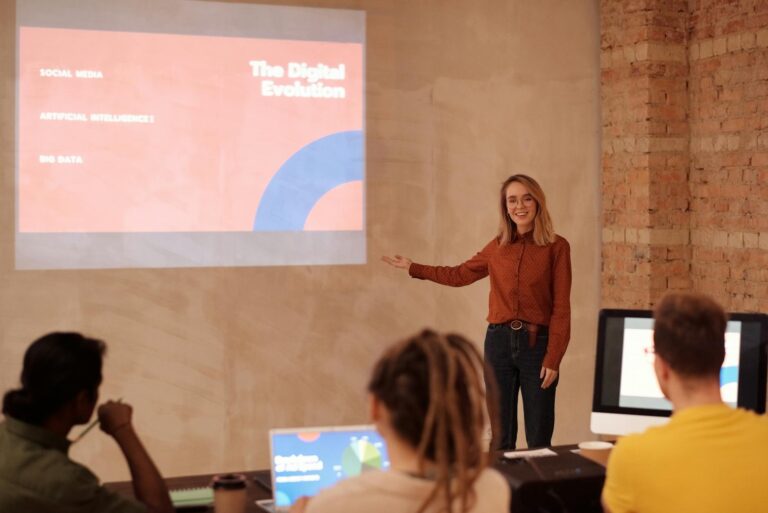Unlock Growth with the 2025 Tech Trends Playbook
The 2025 Tech Playbook: Mastering Web, Mobile, Cloud, AI, and UI/UX for Unprecedented Business Transformation
Estimated Reading Time: 19 minutes
Key Takeaways:
- Web Development is Performance-First: Emphasizing Next.js, headless CMS, and AI-powered personalized experiences for speed, resilience, and user-centricity.
- Mobile Apps are Cross-Platform & Intelligent: The Flutter vs. React Native debate continues, with AI integration driving seamless, context-aware, and accessible mobile experiences across devices.
- Cloud & DevOps are Foundational: Serverless architecture, robust cloud migration strategies, CI/CD automation, and microservices are key for building scalable, efficient, and secure digital infrastructures.
- AI Automation Drives Efficiency & Innovation: AI is transforming the workforce by automating tasks, powering intelligent chatbots, optimizing workflows (e.g., n8n), and enabling data-driven decision-making, while ethical AI governance grows in importance.
- UI/UX is Strategic & Inclusive: Modern design goes beyond aesthetics, focusing on user-centricity, hyper-personalization, accessibility, and leveraging AI to craft intuitive and engaging digital experiences across all devices, including emerging AR/VR.
Table of Contents
- Introduction: The Accelerating Pace of Digital Transformation in 2025
- Web Development Reimagined: Speed, Scale, and User-Centricity
- Mobile App Innovation in 2025: Seamless Experiences and Cross-Platform Excellence
- Cloud Computing & DevOps: The Backbone of Modern Digital Infrastructure
- AI Automation for Businesses: Driving Efficiency and Innovation
- Modern UI/UX Design: Crafting Intuitive and Engaging Digital Experiences
- Digital Transformation Strategies: A Holistic Approach for Growth
- FAQs about 2025 Tech Trends
- Conclusion: Embracing the Future with Strategic Tech Adoption
Introduction: The Accelerating Pace of Digital Transformation in 2025
The digital world is not just evolving; it’s accelerating at an unprecedented rate. As we step into 2025, the lines between emerging technologies are blurring, creating a synergistic ecosystem that promises to redefine how businesses operate, innovate, and connect with their customers. From lightning-fast web experiences to intelligent mobile applications, from infinitely scalable cloud infrastructures to pervasive AI automation, and from intuitive user interfaces to comprehensive digital transformation strategies – the landscape is ripe with opportunities.
For business owners, developers, and tech enthusiasts alike, understanding these shifts isn’t just about staying current; it’s about strategizing for sustainable growth and competitive advantage. The technologies emerging and maturing in 2025 are not mere upgrades; they are foundational shifts that demand a proactive approach. This comprehensive guide, your 2025 tech playbook, breaks down complex trends into simple, actionable insights. It’s designed to show you how today’s cutting-edge tech can accelerate growth, drastically improve performance, and fundamentally transform the way your company operates. At AITechScope, we believe in leveraging these advancements to empower businesses, specializing in AI-powered automation, n8n workflow development, and intelligent delegation to optimize processes and unlock new efficiencies.
Web Development Reimagined: Speed, Scale, and User-Centricity
The web development landscape in 2025 is synonymous with speed, resilience, and deeply personalized user experiences. Developers are no longer just building websites; they’re architecting intricate digital ecosystems designed for peak performance and adaptability.
The Rise of Performance-First Frameworks: Next.js and Beyond
In 2025, the demand for instantaneous loading times and seamless navigation has pushed performance to the forefront of web development. Among the leading contenders, Next.js continues to dominate, becoming a go-to framework for building high-performance, SEO-optimized web applications. Its server-side rendering (SSR), static site generation (SSG), and incremental static regeneration (ISR) capabilities are critical for delivering superior Next.js and React performance, ensuring that even complex applications feel snappy and responsive.
For small businesses, Next.js offers a compelling proposition. Imagine a Next.js small business site that loads almost instantly, outranking competitors in search results due to its speed and excellent core web vitals. Our internal research, “Next.js for Small Businesses: Build a Fast Marketing Site in One Weekend,” highlights how accessible and impactful this framework can be, even for those with limited development resources. A Next.js beginner guide can quickly onboard new developers, enabling them to construct a fast marketing site Next.js ready in record time, translating directly into better lead generation and conversion rates.
Beyond Next.js, the broader React ecosystem emphasizes performance optimization techniques. Simple fixes, as detailed in “5 Simple React Performance Fixes That Reduce Page Load by Seconds,” like memoization, lazy loading components, and optimizing image delivery, are no longer optional but standard practice. These techniques collectively ensure that user engagement remains high and bounce rates low, crucial for any online presence.
Headless CMS and API-First Architectures
The evolution of content management has led to the widespread adoption of headless CMS solutions. In this architecture, the content backend (the “head”) is decoupled from the frontend presentation layer. This microservices architecture approach offers unparalleled flexibility, allowing businesses to publish content across various channels – websites, mobile apps, IoT devices – from a single source of truth, using robust APIs.
Leveraging headless CMS WordPress is a popular strategy for businesses already familiar with WordPress but seeking modern flexibility. By using WordPress as a headless CMS, companies can retain the intuitive content authoring experience while powering a blazing-fast Next.js frontend or a dynamic mobile application. This approach ensures content is future-proof and adaptable to any new digital touchpoint. The agility offered by this API-first design also simplifies the integration of third-party services and paves the way for truly composable digital experiences.
The Power of AI-Powered Web Apps
The integration of artificial intelligence into web applications is no longer a futuristic concept; it’s a rapidly expanding reality in 2025. AI-powered web apps are delivering personalized user experiences, automating tasks, and providing predictive insights. From intelligent chatbots guiding users through complex processes to recommendation engines tailoring content based on browsing history, AI is making web interactions smarter and more engaging.
Our research, “Make Your SaaS Smarter: 3 Low-Effort AI Features That Delight Users,” provides practical examples of how even small integrations can have a significant impact. This includes AI-driven content generation for blogs, smart search functionalities that understand intent, or predictive analytics guiding user journeys. These features enhance user satisfaction, streamline operations, and provide a competitive edge.
Crafting Adaptive Experiences: Responsive UI Design
While responsive design has been a standard for years, 2025 elevates its importance. Modern responsive UI design goes beyond mere adaptability to different screen sizes. It encompasses a holistic approach to user experience, ensuring seamless interactions across diverse devices, including desktops, tablets, mobile phones, smartwatches, and even AR/VR interfaces. The focus is on fluid layouts, touch-friendly interfaces, and performance optimization for every context. Moreover, modern UI/UX design emphasizes accessibility, ensuring that digital products are usable by everyone, regardless of ability. This includes adhering to WCAG guidelines, providing clear navigation, and offering customizable interfaces to cater to varied user needs.
Mobile App Innovation in 2025: Seamless Experiences and Cross-Platform Excellence
Mobile applications remain a cornerstone of digital strategy in 2025, evolving to become more intelligent, integrated, and indispensable to daily life. The focus is on delivering highly performant, engaging, and context-aware experiences across all devices.
Flutter vs. React Native: The Cross-Platform Showdown for 2025
The debate over the best cross-platform framework, Flutter vs React Native, continues to be a central theme in mobile app development 2025. Both frameworks have matured significantly, offering robust solutions for businesses aiming to reach a broad audience without the overhead of maintaining separate iOS and Android codebases.
Our dedicated research, “React Native vs Flutter in 2025: Which Is Best for Your Business App?”, dives deep into their comparative strengths. Flutter, backed by Google, is celebrated for its declarative UI, excellent performance (nearing native levels), and a rich set of widgets that allow for pixel-perfect designs. It’s often favored for apps requiring highly custom UIs and animations. “Build a Simple Cross-Platform App with Flutter: From Idea to Play Store” demonstrates its ease of use for rapid development.
React Native, leveraging JavaScript and the vast React ecosystem, remains incredibly popular for its developer familiarity and the ability to share code with web applications. It offers a quicker development cycle for many standard business applications and has a massive community support base.
For startups, the choice of which mobile framework for startups largely depends on existing team expertise, specific app requirements, and long-term vision. Both provide excellent tools to build high-quality, performant applications, making the decision more nuanced than a clear winner.
AI Integration in Mobile Apps
Just like web apps, mobile applications are becoming increasingly intelligent through AI integration. From personalized content feeds and predictive text to advanced image recognition and voice assistants, AI is making mobile experiences more intuitive and proactive. On-device machine learning is enabling real-time processing and enhancing privacy, allowing apps to perform complex tasks without constant cloud communication. This leads to features like smart notifications, personalized health tracking, and adaptive interfaces that learn user preferences over time.
Modern Mobile App UI Trends
The mobile app UI trends for 2025 are centered around creating seamless, delightful, and efficient user journeys. Expect to see:
- Micro-interactions: Subtle animations and visual feedback that make apps feel more alive and responsive.
- Intuitive Gesture-based Navigation: Reducing clutter by relying more on swipes, pinches, and taps for navigation.
- Dark Mode Optimization: Not just a toggle, but a thoughtful design choice for improved readability, reduced eye strain, and battery efficiency.
- Accessibility First: Designing with inclusivity in mind, ensuring apps are usable for individuals with diverse needs.
- Immersive Elements: Leveraging AR capabilities for interactive product previews or engaging educational content.
The Edge of Mobile: PWA and Instant Apps
Progressive Web Apps (PWAs) and Instant Apps continue to bridge the gap between native mobile applications and traditional websites. PWAs offer app-like experiences directly from the browser, complete with offline capabilities, push notifications, and home screen installation, all without the need for an app store. Instant Apps provide native app functionalities without requiring a full download, offering snippets of an app’s features on demand. Both technologies are crucial for businesses looking to enhance discoverability, reduce friction in user acquisition, and provide faster, more accessible experiences.
Cloud Computing & DevOps: The Backbone of Modern Digital Infrastructure
In 2025, cloud computing and DevOps are no longer just buzzwords; they are the fundamental pillars supporting agile, scalable, and resilient digital operations. Businesses are increasingly relying on these practices to optimize resources, accelerate deployment cycles, and ensure continuous innovation.
Embracing Serverless Architecture
Serverless architecture stands out as a game-changer for its promise of unparalleled scalability and cost efficiency. By abstracting away server management, developers can focus purely on writing code, with the cloud provider automatically handling infrastructure provisioning, scaling, and maintenance. This model is particularly attractive for startups and small businesses.
Consider a serverless AWS cost example: rather than paying for always-on servers that might sit idle during off-peak hours, you only pay for the compute resources consumed when your code actually runs. This pay-per-execution model makes a serverless backend for startups incredibly appealing, significantly reducing operational expenses and allowing for rapid experimentation. Our internal article, “Serverless on AWS: Create a Cost-Efficient Backend That Scales Automatically,” illustrates how this paradigm shift can lead to substantial savings and effortless scaling for demand spikes.
Robust Cloud Migration Strategies
For many established businesses, the journey to the cloud involves migrating existing (often legacy) applications. A well-executed cloud migration strategy is critical to avoid disruptions and unlock the full benefits of cloud infrastructure. Our research, “How to Move Your Legacy App to the Cloud Without Breaking It,” emphasizes the importance of a phased approach, careful planning, and thorough testing. Strategies range from simple “lift and shift” to re-platforming or even re-architecting applications for cloud-native environments. Hybrid cloud models also offer a pragmatic solution, allowing businesses to retain sensitive data on-premises while leveraging public cloud for scalable workloads.
DevOps Best Practices and CI/CD Automation for Efficiency
DevOps best practices are about fostering collaboration between development and operations teams to shorten the systems development life cycle and deliver high-quality software continuously. A core component of this is CI/CD automation. Continuous Integration (CI) involves developers frequently merging code changes into a central repository, where automated builds and tests are run. Continuous Delivery/Deployment (CD) then automates the release of validated code to production.
For CI CD small team environments, tools like GitHub Actions provide an accessible entry point. Our guide, “CI/CD for Small Teams: Automated Deployments Without the Headache,” demonstrates how a GitHub Actions deploy tutorial can empower small teams to implement robust automation. This eliminates manual, error-prone deployment processes, ensuring faster release cycles and improved software quality. CI/CD automation reduces the time from idea to production, a crucial factor in the fast-paced 2025 market.
Microservices and Containerization
The adoption of microservices architecture continues to grow, breaking down large applications into smaller, independently deployable services. This modularity enhances agility, resilience, and scalability. Each microservice can be developed, deployed, and scaled independently, reducing the impact of failures and accelerating development.
Containerization, primarily driven by Docker and orchestrated by Kubernetes, is the enabling technology for microservices. Containers package applications and their dependencies into isolated units, ensuring consistent operation across different environments – from a developer’s laptop to production cloud servers. This combination allows for highly efficient resource utilization and flexible deployment strategies.
The Future of Cloud Security and Compliance
As more critical workloads move to the cloud, cloud security and compliance become paramount. 2025 sees an increased focus on robust security frameworks, automated threat detection, and proactive compliance management. Multi-factor authentication, identity and access management (IAM), encryption at rest and in transit, and continuous security monitoring are standard. Businesses are also navigating complex regulatory landscapes, requiring cloud providers and users to implement stringent data governance and privacy controls.
AI Automation for Businesses: Driving Efficiency and Innovation
Artificial intelligence continues its rapid ascent, transitioning from experimental technology to an indispensable tool for business efficiency and innovation in 2025. Its impact is felt across industries, reshaping workflows and redefining the nature of work itself.
AI’s Transformative Impact on the Workforce
Recent research from MIT, highlighted by CBS News, reveals a profound truth: AI can already do the work of 12% of America’s workforce. This isn’t about job replacement as much as it is about job transformation. AI is taking over repetitive, data-intensive tasks, freeing human employees to focus on strategic thinking, creativity, and complex problem-solving. We’re seeing a shift from task automation to intelligent augmentation, where AI acts as a co-pilot, enhancing human capabilities rather than simply replacing them. The third anniversary of ChatGPT, which sparked a breakthrough period for AI as reported by WBFF, underscores the rapid pace at which these capabilities have evolved and been adopted.
Chatbot Automation and Intelligent Customer Service
Chatbot automation has moved far beyond simple rule-based systems. In 2025, AI chatbots for customer service are intelligent, context-aware, and capable of handling complex queries with human-like understanding. They provide 24/7 support, instant answers, and personalized interactions, significantly improving customer satisfaction and reducing operational costs. Our article, “How Small Businesses Use Chatbots to Save Time: Real Workflows That Work,” provides practical examples of how even small companies can deploy sophisticated AI-powered chatbots to manage inquiries, qualify leads, and provide information, ultimately saving significant time for their teams.
Workflow Automation Tools and Process Optimization
The true power of AI in business lies in its ability to optimize and automate workflows across departments. Workflow automation tools, especially when augmented with AI, can streamline everything from marketing campaigns and HR onboarding to financial reconciliation and supply chain management. The article “Automate Repetitive Tasks with No-Code Tools + AI (Save 5–10 Hours/Week)” illustrates the immense potential for efficiency gains.
This is where AITechScope truly shines. As a leading provider of virtual assistant services, we specialize in AI-powered automation and n8n workflow development. Our expertise lies in connecting disparate systems, designing intelligent workflows, and leveraging cutting-edge AI tools to achieve significant business process optimization. We help businesses scale operations, reduce costs, and improve efficiency through intelligent delegation and automation solutions, effectively becoming their trusted partner in navigating this new era of productivity.
Ethical AI and Governance: Navigating the New Frontier
As AI becomes more pervasive, the discussions around ethical AI and robust governance frameworks are intensifying. The news about the New York City Council setting up a new AI Oversight Office reflects a growing global awareness of the need for responsible AI development and deployment. In 2025, businesses must prioritize transparency, fairness, and accountability in their AI systems. This involves mitigating bias in algorithms, ensuring data privacy, and establishing clear guidelines for AI usage. Trust in AI is paramount, and companies that prioritize ethical considerations will build stronger relationships with their customers and stakeholders.
AI-Powered Data Analytics and Decision Making
Beyond automation, AI is revolutionizing how businesses extract insights from their data. AI-powered data analytics tools can process vast datasets, identify complex patterns, and generate predictive models far beyond human capabilities. This enables more informed and strategic decision-making, from optimizing marketing spend and product development to forecasting market trends and identifying new business opportunities. As AI reshapes shopping, as Reuters reported, retailers are using AI to understand consumer behavior and personalize experiences online, demonstrating the real-world impact of AI-driven insights.
Modern UI/UX Design: Crafting Intuitive and Engaging Digital Experiences
In 2025, exceptional UI/UX design is no longer a luxury; it’s a fundamental requirement for digital success. As technology becomes more sophisticated, user expectations for intuitive, delightful, and inclusive experiences continue to rise.
Beyond Aesthetics: The Science of User-Centric Design
Modern UI/UX design is deeply rooted in psychology and human-computer interaction. It goes far beyond visual appeal, focusing on user research, usability testing, and iterative design to create interfaces that are not only beautiful but also highly effective and enjoyable to use. The emphasis is on reducing cognitive load, streamlining workflows, and creating clear pathways for users to achieve their goals.
Crucially, responsive UI design is intertwined with accessibility. Designing for all users, including those with disabilities, is paramount. Our article, “Designing Accessible Buttons: A Non-Designer’s Guide (Figma Tips),” underscores how thoughtful design choices, even at a granular level, can make a profound difference in inclusivity and user experience. This includes sufficient contrast, clear focus states, and proper semantic markup.
Personalization and Adaptive Interfaces
The future of UI/UX is hyper-personalization. Interfaces in 2025 will adapt dynamically to individual user preferences, behaviors, and contexts. This means tailoring content, layouts, and even functionalities based on past interactions, location, device, and time of day. AI plays a significant role here, powering algorithms that learn and predict user needs, offering truly unique and relevant digital journeys. This level of adaptation transforms generic experiences into highly engaging and efficient ones.
Immersive UI/UX: AR/VR and Spatial Computing
While perhaps not mainstream for every business, the advancements in Augmented Reality (AR), Virtual Reality (VR), and spatial computing hint at the next generation of user interfaces. In 2025, we’re seeing more practical applications of AR in retail (virtual try-ons), education (interactive learning), and manufacturing (maintenance overlays). These immersive experiences offer new paradigms for interaction, allowing users to engage with digital content in a more physical and intuitive way. Designers are beginning to explore how to create intuitive navigation and interaction patterns within these new, three-dimensional digital environments.
The Role of AI in UI/UX Design
AI is not just consumed through interfaces; it’s also actively shaping them. AI-powered design tools are assisting designers with everything from generating initial wireframes and optimizing layouts to predicting user behavior and conducting automated A/B tests. This allows designers to accelerate their workflow, focus on higher-level strategic thinking, and iterate faster. AI can analyze vast amounts of user data to suggest optimal color palettes, typography, and even content placements, leading to more data-driven and effective design decisions.
Digital Transformation Strategies: A Holistic Approach for Growth
Digital transformation in 2025 is less about adopting individual technologies and more about a holistic, strategic reimagining of an organization’s operations, culture, and customer interactions. It’s about leveraging technology to drive fundamental business change and create sustainable competitive advantage.
Enterprise Digital Adoption and Scaling Innovation
For large organizations, enterprise digital adoption presents unique challenges, often involving legacy systems, complex organizational structures, and significant change management. The key to scaling innovation in these environments lies in fostering a culture of agility, investing in employee upskilling, and strategically integrating new technologies with existing infrastructure. This might involve adopting micro frontends to gradually modernize large applications, as explored in “Micro Frontends: When They Help and When They Hurt (Practical Examples).” Such strategies allow enterprises to evolve without disruption, ensuring that digital transformation isn’t a one-time project but a continuous journey of improvement.
Digital Innovation for Startups and Small Businesses
While enterprises face the challenge of scale, startups and small businesses have the advantage of agility. Digital innovation for startups and tech innovation for small businesses often means leveraging cost-effective, cloud-native solutions and agile methodologies to rapidly iterate and find market fit. Our guide, “Digital Transformation on a Budget: 7 Steps Small Companies Can Start Today,” provides a roadmap for small businesses to initiate their digital journey without breaking the bank. This includes adopting SaaS tools, implementing workflow automation, and building an optimized tech stack for modern businesses that prioritizes scalability and efficiency. The focus here is on achieving maximum impact with minimal resources, utilizing tools like Next.js for marketing sites or serverless backends for scalable services.
SaaS Product Optimization and Continuous Improvement
For businesses developing SaaS products, SaaS product optimization is a continuous process in 2025. It involves constant iteration based on user feedback, data analytics, and market trends. Performance optimization techniques are critical, not just for speed but also for user retention and satisfaction. This includes improving backend efficiency, optimizing frontend rendering, and ensuring seamless integration with other tools. A focus on user experience, proactive customer support, and strategic feature development ensures that SaaS offerings remain competitive and valuable in a crowded market.
AITechScope: Your Partner in Digital Transformation
Navigating the complexities of software development 2025 and implementing these advanced strategies can be daunting. This is precisely where AITechScope steps in. We are not just a service provider; we are a strategic partner dedicated to helping businesses thrive in this dynamic environment. Our expertise in AI-powered automation, n8n workflow development, and business process optimization enables companies to effectively leverage cutting-edge AI tools and technologies.
Whether it’s integrating AI-powered web apps, implementing CI/CD automation for a small team, building a serverless backend for startups, or driving broader enterprise digital adoption, AITechScope provides intelligent delegation and automation solutions designed to scale operations, reduce costs, and significantly improve efficiency. We empower businesses to transform their operations, from enhancing customer service with AI chatbots for customer service to optimizing internal workflows with workflow automation tools. Partner with us to turn the challenges of 2025 tech trends into tangible opportunities for growth and innovation.
FAQs about 2025 Tech Trends
Q1: What are the most significant web development trends for 2025?
A1: The most significant web development trends for 2025 include a strong emphasis on performance with frameworks like Next.js, the widespread adoption of headless CMS and API-first architectures for flexibility, the integration of AI-powered features for personalized experiences, and advanced responsive UI design focusing on accessibility and immersive elements. Expect faster loading times, highly interactive interfaces, and more intelligent web applications.
Q2: How do Flutter and React Native compare for mobile app development in 2025?
A2: In 2025, both Flutter and React Native remain top contenders for cross-platform mobile app development. Flutter (backed by Google) is lauded for its superior UI rendering capabilities, near-native performance, and developer-friendly Dart language, often chosen for highly custom and animated UIs. React Native (backed by Meta) benefits from its large JavaScript ecosystem and community, offering faster development for many standard business apps and excellent code reusability with web projects. The best choice depends on your team’s existing skill set, specific app design requirements, and desired performance characteristics.
Q3: What is serverless architecture, and how can it benefit small businesses?
A3: Serverless architecture is a cloud execution model where the cloud provider dynamically manages the allocation and provisioning of servers. Developers only write and deploy code (functions), and the infrastructure scales automatically based on demand. For small businesses, serverless offers significant benefits: greatly reduced operational costs (you only pay for actual compute time), automatic scalability for fluctuating traffic, faster development cycles, and minimal server management overhead, allowing teams to focus on core product features.
Q4: How is AI automation impacting business operations and the workforce?
A4: AI automation in 2025 is profoundly impacting businesses by streamlining repetitive tasks, optimizing complex workflows, and enabling intelligent decision-making. It augments the workforce by freeing employees from mundane duties, allowing them to focus on creativity, strategy, and problem-solving. AI-powered chatbots enhance customer service, while internal AI tools improve efficiency in areas like marketing, HR, and data analysis. This leads to increased productivity, cost reduction, and more data-driven insights, fundamentally transforming how companies operate.
Q5: What are the key considerations for a successful digital transformation strategy?
A5: A successful digital transformation strategy in 2025 requires a holistic approach. Key considerations include: fostering an agile and innovative company culture, investing in cloud-native solutions and robust DevOps practices, prioritizing user-centric and accessible UI/UX design, strategically integrating AI and automation across operations, and focusing on continuous improvement through data analytics. For enterprises, effective change management is crucial, while small businesses benefit from cost-effective tech stacks and rapid iteration.
Q6: How can AITechScope help my business adopt these 2025 tech trends?
A6: AITechScope specializes in empowering businesses to leverage 2025 tech trends through AI-powered automation, n8n workflow development, and business process optimization. We provide intelligent delegation and automation solutions that help you scale operations, reduce costs, and improve efficiency. Whether you need to integrate AI into your web apps, optimize your mobile development strategy, implement robust CI/CD, or streamline workflows with AI, our expertise can transform your digital strategy into tangible business growth.
Conclusion: Embracing the Future with Strategic Tech Adoption
The year 2025 stands as a pivotal moment in the digital age, characterized by an unprecedented convergence of advanced technologies. From the blazing speed of Next.js-powered web applications and the seamless experiences of Flutter and React Native mobile apps, to the infinitely scalable backbones of serverless cloud architectures and the transformative power of AI automation – the tools for unprecedented growth and efficiency are at our fingertips. Modern UI/UX design ensures that these powerful technologies remain accessible and delightful for every user, while comprehensive digital transformation strategies provide the roadmap for integrating them effectively across an entire organization.
The message is clear: proactive adaptation is no longer an option but a necessity. Businesses that embrace these 2025 tech trends strategically will not only survive but thrive, carving out new market opportunities and delivering unparalleled value to their customers. This digital evolution demands more than just technology adoption; it requires a mindset shift, a commitment to continuous learning, and a willingness to reimagine what’s possible.
At AITechScope, we are passionately committed to guiding businesses through this transformative landscape. Our expertise in AI-powered automation, n8n workflow development, and business process optimization makes us the ideal partner for companies looking to harness the full potential of intelligent delegation and cutting-edge tech. We help you move beyond simply understanding these trends to actively implementing solutions that scale operations, reduce costs, and improve efficiency. Let’s embark on this journey together, turning the challenges of tomorrow’s tech into your competitive advantage today. The future is here, and with strategic tech adoption, your business can lead the way.







